|
C O
R A L
C O U R T :
The No-Tell Motel with a Touch of Class
( 1 9 4 1 - 1 9 9 5 )
Illicit
fun • Bring Your Own Sheets • The Suicide Capital of St.
Louis County
• The Crown Jewel of St. Louis • Quickies
• Architectural Excellence
• Pleasure Palace • Two-Lane
America
|
Few motels
on Route 66, or anywhere for that matter, elicit the wide variety of responses
as the Coral Court Motel in St. Louis, Missouri. For mystery, intrigue
and sheer tawdriness, you can’t beat the Coral Court.
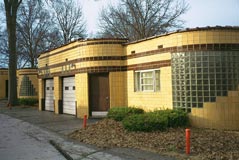 The
glazed brick motor court, formerly at 7755 Watson Road, was located just
one mile west of the St. Louis city limits. Designed in the 1940’s
Streamline Moderne style, the Coral Court was described by author Michael
Wallis as “the proverbial ‘no-tell motel’ with a definite
touch of class.” The motel was the premier surviving example of a
motor court, an early phase of the motel. It was also highly regarded
as one of the finest examples ever built in this late Art Deco style.
Coral Court first became famous because of its prime location on Route
66, just outside of St. Louis. Heading west on the mother road, it was
a natural stop after a day’s drive from Chicago. The
glazed brick motor court, formerly at 7755 Watson Road, was located just
one mile west of the St. Louis city limits. Designed in the 1940’s
Streamline Moderne style, the Coral Court was described by author Michael
Wallis as “the proverbial ‘no-tell motel’ with a definite
touch of class.” The motel was the premier surviving example of a
motor court, an early phase of the motel. It was also highly regarded
as one of the finest examples ever built in this late Art Deco style.
Coral Court first became famous because of its prime location on Route
66, just outside of St. Louis. Heading west on the mother road, it was
a natural stop after a day’s drive from Chicago.
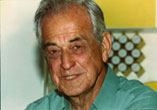 On
June 11, 1941, the St. Louis Daily Record reported that owner John H.
Carr
planned to build 10 two-room cabins and a central building at a cost
of seven thousand dollars. St. Louis architect, Adolph
L. Struebig,
was hired
to build John Carr’s vision of the best motel in St. Louis. Struebig
was quoted in an interview with E.F. Porter of the St. Louis Post-Dispatch,
“There were a lot of mom-and-pop motels in those days, little buildings
of eight to twelve units. Johnnie didn’t want anything like that,
he wanted something outstanding.” See John Carr with his grandson John Dover. On
June 11, 1941, the St. Louis Daily Record reported that owner John H.
Carr
planned to build 10 two-room cabins and a central building at a cost
of seven thousand dollars. St. Louis architect, Adolph
L. Struebig,
was hired
to build John Carr’s vision of the best motel in St. Louis. Struebig
was quoted in an interview with E.F. Porter of the St. Louis Post-Dispatch,
“There were a lot of mom-and-pop motels in those days, little buildings
of eight to twelve units. Johnnie didn’t want anything like that,
he wanted something outstanding.” See John Carr with his grandson John Dover.
Struebig designed and built the original 10 bungalows in grand style.
The honey-colored glazed ceramic bricks and large glass block windows
gleamed in the sunlight, or reflected the headlights of your 1950 Buick
Roadmaster at night.
There were two different architects who designed and built Coral Court,
although credit has usually been given to one. During the course of the
research for my book I found there was a second architect, Harold
Tyrer,
who was responsible for more than half of the Coral Court complex. Tyrer
designed and built the exceptional 1946 cottages, which feature two rounded
bays and pyramid-shaped glass block windows.
 1941 floorplan
(original) 1941 floorplan
(original)
|
 1946 floorplan 1946 floorplan
|
After World
War II, from 1946-48, twenty-three new buildings (or 46 rooms) were completed.
Motel enthusiasts refer to this bungalow style as the “Mae West”
unit because of the curvy, rounded bays. After the 2-story units were
built near the back of the complex, the final tally reached 77 rooms.
Yet the highest room number was only #65. This was because of the odd
numbering system of the 2-story rooms: #51, 51a, 52, 52a. “A”
indicated upstairs rooms.
To roadside fans, Coral Court was a shrine. To many St. Louisans, the
motel was a rite of passage. Attending a late night prom party and escaping
with a Court towel or matchbook was a must for any local teenager. For
many who prefer to remain anonymous, the motel was the place “to
get that groove on;” and of course there were always the chaste few
who considered it “a monument to adultery”. How did Coral Court
get its reputation? Three reasons: (1) The rooms could be rented for a
rest period of 4 or 8 hours (initially created as a courtesy to truck
drivers), but not actually hourly rates as is often said. (2) Every room
had its own garage, so cars were hidden from passersby. The clean and
cozy bungalows, with attached private garages, provided whispered asides
and off-colored jokes for decades. (3) The management at Coral Court was
very discreet. The legend of the motel spread across the United States
and beyond.
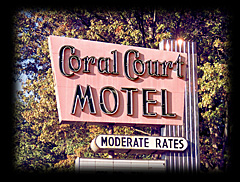
T H E N E O N S I G N
One of the most memorable parts of the Coral Court legacy was the eye-catching
sign on the edge of Watson Road. It advertised quality and style with
its neon and chrome. During my research, another interesting research
fact was discovered: the famous pink Coral Court sign was not the original.
When Coral Court opened in 1942, there was an Art Deco gold & red
sign that displayed, “Coral Court, Ultra Modern”. A small pennant
was attached at the top. This initial design can be confirmed by the view
on this vintage postcard. Later, circa 1948, the sign was changed slightly.
The word “Modern” is replaced by a new word “Motel.” This sign was used until the early 1950s.
That impressive, pink Coral Court sign, that we all remember, was not
created until around 1952. It was reminiscent of the original Holiday
Inn “Great sign”. Coral Court’s new sign proclaimed “Moderate
Rates”, while the lower banner with moveable letters declared, “Room
Phones, Free Television, Air Conditioning, Swimming Pool”. (Cool 1957 advertisement) This distinctive
neon sign lured customers to check-in until 1993. In November, three months
after the motel closed, the owners ordered the sign taken down and destroyed.
T
H E G
R E E N L E A S E C A S E
A
particularly notorious moment in the life of the motel was the Greenlease
kidnapping case. On September 28, 1953, six-year old Bobby Greenlease
Jr. was kidnapped from his Kansas City, Kansas school by Carl Austin Hall
and Hall’s mistress, Bonnie Heady. In a series of phone conversations,
Hall repeatedly assured Bobby’s parents that the boy was alive and
well. 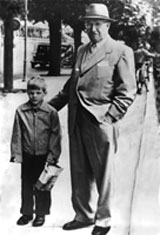 Unaware that his child had already been murdered, millionaire Robert
C. Greenlease paid $600,000 in a desperate effort to save his son. Hall
and Heady collected the ransom, crossed the state line and fled to St.
Louis. Hall hid out for two days at the Coral Court Motel. An odd assortment
of St. Louisans—a policeman, a crook, a cab driver and a prostitute—were
all instrumental in the capture of Bobby’s killers. The incident
received national attention and is often compared to the infamous Lindbergh
kidnapping. Unaware that his child had already been murdered, millionaire Robert
C. Greenlease paid $600,000 in a desperate effort to save his son. Hall
and Heady collected the ransom, crossed the state line and fled to St.
Louis. Hall hid out for two days at the Coral Court Motel. An odd assortment
of St. Louisans—a policeman, a crook, a cab driver and a prostitute—were
all instrumental in the capture of Bobby’s killers. The incident
received national attention and is often compared to the infamous Lindbergh
kidnapping.
Carl Austin Hall and Bonnie Heady both pleaded guilty. A jury in Kansas
City recommended the death penalty. Eighty-seven days after the murder,
Hall and Heady were executed in the gas chamber at the state penitentiary
in Jefferson City. Somewhere, somehow, half of the ransom money—$300,000—disappeared.
Many people believed that the missing money was stashed on the premises
of the Coral Court Motel.
The mystery of what happened to the $300,000 has never been solved. Recently,
I spoke with a lady whose husband was an FBI agent assigned to the Greenlease
case. She told me the case is still open, 50+ years later. (I haven’t
phoned the FBI to confirm that, but I thought it was interesting.)
______________________________________________________
For two years, I interviewed dozens of people who stayed, played and
worked
at the Coral Court Motel. Here are a few of my favorite quotes from the
book:
“I admired its architecture, if not its
bedsprings.”
—S.L.,
St. Louis
“It’s a dark, sleazy place with
bad memories.”
—Marie,
Fenton, Missouri
“It seems so unconscionable that it
could be destroyed. I liken it to crucifixion.”
—Bob Waldmire, Rochester, Illinois
“I lived in my van and delivered flowers. She was high society and
very married. I had never been to the Coral Court, but I’d heard
about it since high school. It became a Shangri-la solution, 10:30 to
2:30 p.m. every Tuesday.”
—Bob B., St. Louis
“…I loved working there, I really did. It was fun during the
pool days. What really was the final blow for the tourist business at
Coral Courts was when the pool was no longer open…”
—Alan
S. former employee (1973-1982), St. Louis
“It was an institution. I’ve got a glass block, a tin ashtray,
some towels and a matchbook. I grew up here and spent my whole life here
in St. Louis. Coral Courts, even as a child, you heard the older people
talking about it. It had its nefarious reputation, but when you drove
by it, it was a beautiful little affection, with its trees and all that.
A lot of people didn’t know that place and [that] there were two
different check-ins. Like if you were a tourist wanting to spend the night,
you went in one section. If you were [there] for the notorious 3-hours,
that was another section. Because they didn’t want the tourists
being upset by the garage doors clanging all night long.”
—Ron
Raumschuh, St. Louis
(NOTE:
Sadly, Mr. Raumschuh passed away on May 23, 2003. He participated
in both the Coral Court BOOK & documentary.) |
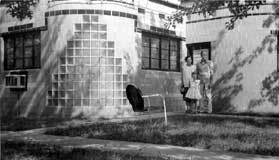 “Most
people laugh when they hear the name Coral Court, and think of it as a
seedy place. My recollection—maybe I’m one of the few in St.
Louis—is that it was an extraordinary place. As a kid, we swam there
frequently and met nice families. Some people came back year after year
to the Coral Court Motel…My recollection was not a place for one-night
stands; I remember it as kind of a classy place.” “Most
people laugh when they hear the name Coral Court, and think of it as a
seedy place. My recollection—maybe I’m one of the few in St.
Louis—is that it was an extraordinary place. As a kid, we swam there
frequently and met nice families. Some people came back year after year
to the Coral Court Motel…My recollection was not a place for one-night
stands; I remember it as kind of a classy place.”
—Rick Anthony,
Ellisville, Missouri
“In the ’70s, for our anniversary…I took my husband out
to dinner and asked him if I could drive home. Then I drove him to Coral
Courts. It had such a reputation; I had to stay there just to find out
if there were mirrors on the ceiling, television sets on the ceiling and
if the beds were really warm…It was just a nice comfortable room
with a bath.”
—Marilyn H., St. Louis
“Along 66, there were motels shaped like tepees and taco stands built
like sombreros. There’s so much history in this highway. It was the
style of an era, it is our culture. Of course, we don’t see anything
like it anymore. What are we building nowadays that’s real cool,
like the Coral Court Motel?”
—Ray Benson, founder of the Texas
swing band “Asleep at the Wheel”
______________________________________________________
L
O O K I N G B A C K
Actions by retail developers and the motel owners in the late 1980’s
and the early 1990’s, led architectural experts and Coral Court fans
on a preservation crusade. Unfortunately, even a listing on the National
Register of Historic Places, pushed for and received in 1989, did not
provide protection from the wishes of its owners, private developers and
a demolition permit. A property on the National Register is only protected
if federal funds are involved. Also, the Village of Marlborough had no
local historic preservation laws like the City of St. Louis; even after
the State of Missouri passed a law enabling all towns, cities and villages
to have historic preservation districts and ordinances, the village fathers
were simply not interested. The motel owners did not want to be bothered
with Coral Court any longer and their attorney advised them to sell.
As the fate of the landmark became clear, the concern of its supporters
shifted to preventing further deterioration of the motel while it was
on the market. Although the motel was roped off and patrolled regularly
by the police, it did not prevent “souvenirs-seekers” and vandals
from breaking into the rooms. Some even loaded the bricks into their cars,
hoping they would become a valuable investment for future resale. Tragically,
they hastened the destruction of the unique landmark.
 The
Coral Court Motel was closed in 1993 and razed two years later. The motel
was actively on the market for nearly 3 years but nobody was able to afford
the $1.5 million pricetag plus the extra $1 million estimated for renovation.
Shortly before its destruction in 1995, Coral Court preservationists remained
loyal. The Museum of Transportation in St. Louis, where a Coral Court
unit was planned to be moved and eventually displayed, could not afford
the more than $100,000 to move the building intact. The
Coral Court Motel was closed in 1993 and razed two years later. The motel
was actively on the market for nearly 3 years but nobody was able to afford
the $1.5 million pricetag plus the extra $1 million estimated for renovation.
Shortly before its destruction in 1995, Coral Court preservationists remained
loyal. The Museum of Transportation in St. Louis, where a Coral Court
unit was planned to be moved and eventually displayed, could not afford
the more than $100,000 to move the building intact.
Once again, Coral Court fans came through. The museum staff and an all-volunteer
labor force of about twenty, showed up for the bungalow’s solitary
trip to the museum. For two-and-a-half-weeks, they they dismantled the
selected unit, piece by piece; stacking heavy bricks and blocks. Working
on the unit’s outside portion, these determined volunteers unhinged
doorways, lifted garage doors and pried off aluminum windows. While on
the inside, they carefully unscrewed fixtures, coat racks and curtain
rods, and carried out any remaining furniture. History owes all of the
museum staff and volunteers a huge thank-you for their selfless labor.
T
H E C
O R A L C
O U R T R I S E S A
G A I N
After
sitting in storage for five years, a new feature at the Museum of
Transportation was built in May 2000. It is a semi-permanent exhibit
about the Coral Court Motel.
It features the Streamline Moderne facade of one of the motel’s
1946 units built of glazed brick and glass blocks. Once again these
original
materials are back together for our appreciation. The exhibit also covers
the impact of “car culture” on the nation with a 1941 Fleetwood
Cadillac peaking out of the Coral Court garage. Meanwhile Bobby Darin’s
Dream Car, a space age “Jetson-like” fantasy from 1962,
sits close by in the same room. Included in the display are pieces
of CCM memorabilia
and photo examples of other landmarks on U.S. Route 66. When enough funds
are collected, the museum plans to rebuild the entire Coral Court
unit
outdoors for all to enjoy. Can you imagine the sidewalk leading to this
Deco masterpiece? It could be called the “Walk of Shame”.
Yes, for only $$ you can have your name (or anyone else’s name)
engraved in a brick for the sidewalk for all of posterity. :-)
What was built on the site of the former Coral Court? Instead of history,
nostalgia and a fabulous landmark, there is now a subdivision of 45 single-family
homes called Oak Knoll Manor. Only the original, distinctive stone gates
and a few pillars remain. You must look closely to see them behind the
growing trees and shrubbery. The motel’s stone gates and the Oak
Knoll Manor subdivision are located between Sunset Bowling Center and
Rothman Furniture store, in the Village of Marlborough, Missouri. One
of my future projects is to have a historic marker placed in front of
these stone entrance gates, so tourists and locals will have a permanent
reminder of Coral Court.
Sometimes I think about the motel’s last years and the energy spent
fighting to save her. Ardent Coral Court fans fought passionately to preserve
this ageless beauty. There were no true winners. Money, or the lack of
it, won in the end. If there had been just one St. Louis corporation,
or, in the spirit of Coral Court, just one “anonymous” hero
with enough money and concern for this magnificent motel; maybe fifty-four
years of memories, an architect’s vision and an owner’s dream
would not have been destroyed and lost forever.
IF you would like to write to the Village of Marlborough in support of our proposed Coral Court marker, please go to City of Marlborough St. Louis County government page.

FINAL
NOTES: In 2004, Bill
Boll and Shellee Graham completed their award winning video documentary "Built
for Speed: The Coral Court Motel." The
program has received rave reviews from the media and won the 2005 Aurora Award for International Broadcasting. The Museum of Transportation's Automotive Building (where the Coral Court display is housed) underwent an extensive renovation and was reopened in December 2005.
• Browse Coral Court merchandise
• More info on Shellee Graham's books
|





 On
June 11, 1941, the St. Louis Daily Record reported that owner John H.
Carr
planned to build 10 two-room cabins and a central building at a cost
of seven thousand dollars. St. Louis architect,
On
June 11, 1941, the St. Louis Daily Record reported that owner John H.
Carr
planned to build 10 two-room cabins and a central building at a cost
of seven thousand dollars. St. Louis architect, 



 “Most
people laugh when they hear the name Coral Court, and think of it as a
seedy place. My recollection—maybe I’m one of the few in St.
Louis—is that it was an extraordinary place. As a kid, we swam there
frequently and met nice families. Some people came back year after year
to the Coral Court Motel…My recollection was not a place for one-night
stands; I remember it as kind of a classy place.”
“Most
people laugh when they hear the name Coral Court, and think of it as a
seedy place. My recollection—maybe I’m one of the few in St.
Louis—is that it was an extraordinary place. As a kid, we swam there
frequently and met nice families. Some people came back year after year
to the Coral Court Motel…My recollection was not a place for one-night
stands; I remember it as kind of a classy place.” 

